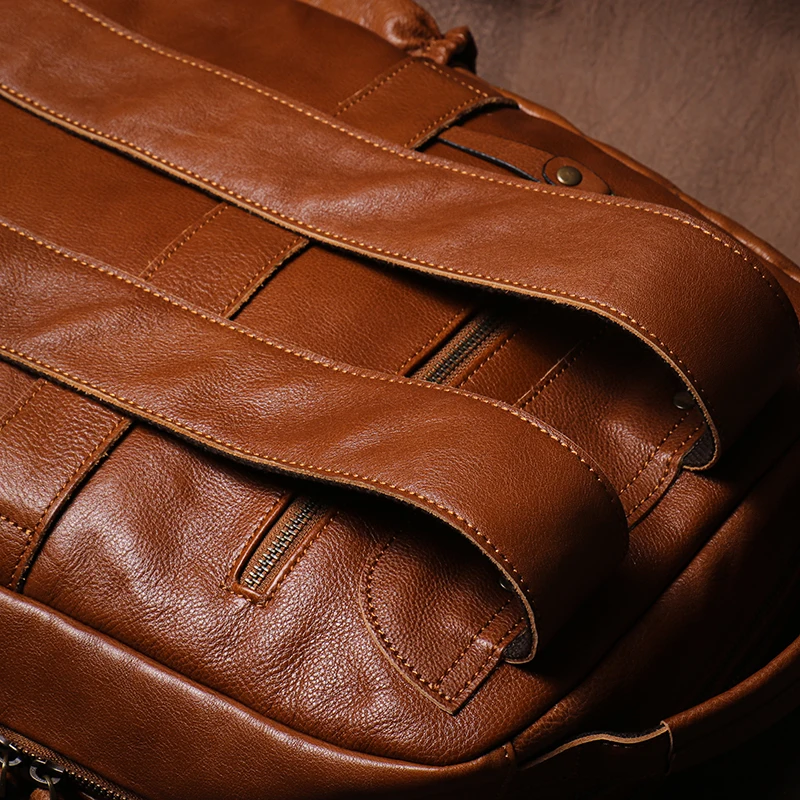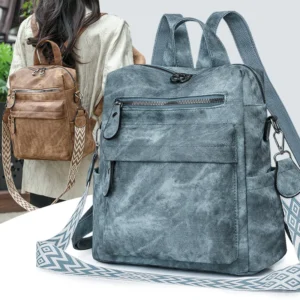Leather backpacks combine style, durability, and functionality, making them a favorite choice for professionals, travelers, and everyday users. However, to keep your leather backpack looking its best and extend its lifespan, proper cleaning and maintenance are essential. This comprehensive guide will walk you through everything you need to know about caring for your leather backpack, from identifying your leather type to advanced stain removal techniques.
Understanding Your Leather Backpack
Before cleaning your leather backpack, it’s crucial to identify what type of leather you’re working with. Different leather types require specific cleaning approaches to avoid damage.
Common leather types include:
Full-grain leather: The highest quality leather that shows natural markings and develops a beautiful patina over time. It has a distinctive, slightly textured surface and is very durable.
Top-grain leather: Slightly processed to remove imperfections, smoother than full-grain, but still durable with natural characteristics.
Genuine leather: Made from lower layers of the hide, less durable than full-grain or top-grain, with a more uniform appearance.
Bonded leather: Created from leather scraps bonded together with adhesives. It has a very uniform look and is less durable.
Suede/Nubuck: Soft leather with a fuzzy, velvety surface that requires specialized cleaning techniques.
Patent/Exotic: Patent leather has a glossy finish, while exotic leathers come from animals like crocodile or ostrich, both requiring special care.
You can identify your leather type by examining its texture, flexibility, and natural markings. Understanding what type of full-grain leather backpack you own will guide your cleaning approach and help preserve its quality for years to come.
Essential Cleaning Supplies for Different Leather Types
Having the right tools and products on hand makes leather care much simpler and more effective. Here’s what you’ll need based on your leather type:
Daily Maintenance Tools:
* Soft microfiber cloths (lint-free)
* Soft horsehair brushes
* Leather dust cloths
Cleaning Solutions:
* For smooth leather: Mild soap (pH neutral) or specialized leather cleaner
* For suede/nubuck: Suede-specific cleaner and brush
* For patent leather: Mild soap solution or specialized patent leather cleaner
Conditioning Products:
* Cream conditioners (for most leather types)
* Oil-based conditioners (for dry or cracked leather)
* Spray conditioners (for suede and nubuck)
Stain Removal Tools:
* Absorbent powders (cornstarch or baking soda for oil stains)
* Leather-safe stain removers
* Cotton swabs for targeted application
* Soft erasers for suede
Protection Products:
* Leather waterproofing sprays
* Leather protectant creams
The specific needs of your backpack will depend on its leather type and finish. For comprehensive protection, consider exploring leather conditioning and waterproofing products specifically formulated for your leather type. Using appropriate leather waterproofing products can provide additional protection against environmental damage.
Pre-Cleaning Preparation: Protect Your Investment
Taking the time to properly prepare your backpack before cleaning will help prevent damage and ensure better results.
Empty the backpack completely: Remove all items from every pocket and compartment. Turn the backpack inside out if possible to remove crumbs and debris.
Inspect thoroughly: Check for stains, scratches, or damage that might need special treatment. Note areas that need extra attention.
Dust thoroughly: Use a soft cloth or brush to remove surface dust from both exterior and interior surfaces. Pay special attention to seams and corners where dust accumulates.
Test cleaning products: Apply a small amount of any cleaning solution to an inconspicuous area (like the bottom or inside) and wait 24 hours to check for adverse reactions such as discoloration.
Prepare your workspace: Choose a clean, well-lit area with a flat surface. Lay down a towel to protect your work surface.
This preparation stage is crucial for identifying potential issues and ensures that your cleaning process won’t cause unexpected damage. Understanding the importance of preparation before conditioning will help you achieve the best results for your leather backpack.
Step-by-Step General Cleaning Method
Once you’ve prepared your backpack, follow these steps for a thorough cleaning:
Initial dust removal: Gently wipe the entire backpack with a dry microfiber cloth to remove surface dust and debris.
Prepare cleaning solution: For most leather types, mix a few drops of mild soap with warm water until slightly sudsy. Avoid creating excess foam.
Dampen a cloth: Dip a clean microfiber cloth into the solution and wring thoroughly. The cloth should be barely damp, not wet.
Clean with proper technique: Wipe the leather using gentle circular motions with light pressure. Work in small sections, starting from the top and moving downward.
Address seams and crevices: Use a slightly dampened cotton swab to clean hard-to-reach areas around zippers, seams, and hardware.
Clean hardware separately: Use a dry cloth to polish metal hardware. For stubborn tarnish, use a specialized metal cleaner applied with a cotton swab, being careful to avoid contact with the leather.
Wipe with clean water: Dampen a fresh cloth with clean water, wring thoroughly, and wipe the backpack to remove soap residue.
Pat dry: Use a dry, clean cloth to gently pat (not rub) the leather, absorbing excess moisture.
These cleaning methods work particularly well for travel backpacks that regularly face different environments and need consistent care. Remember that less is more when it comes to moisture—too much water can damage leather.
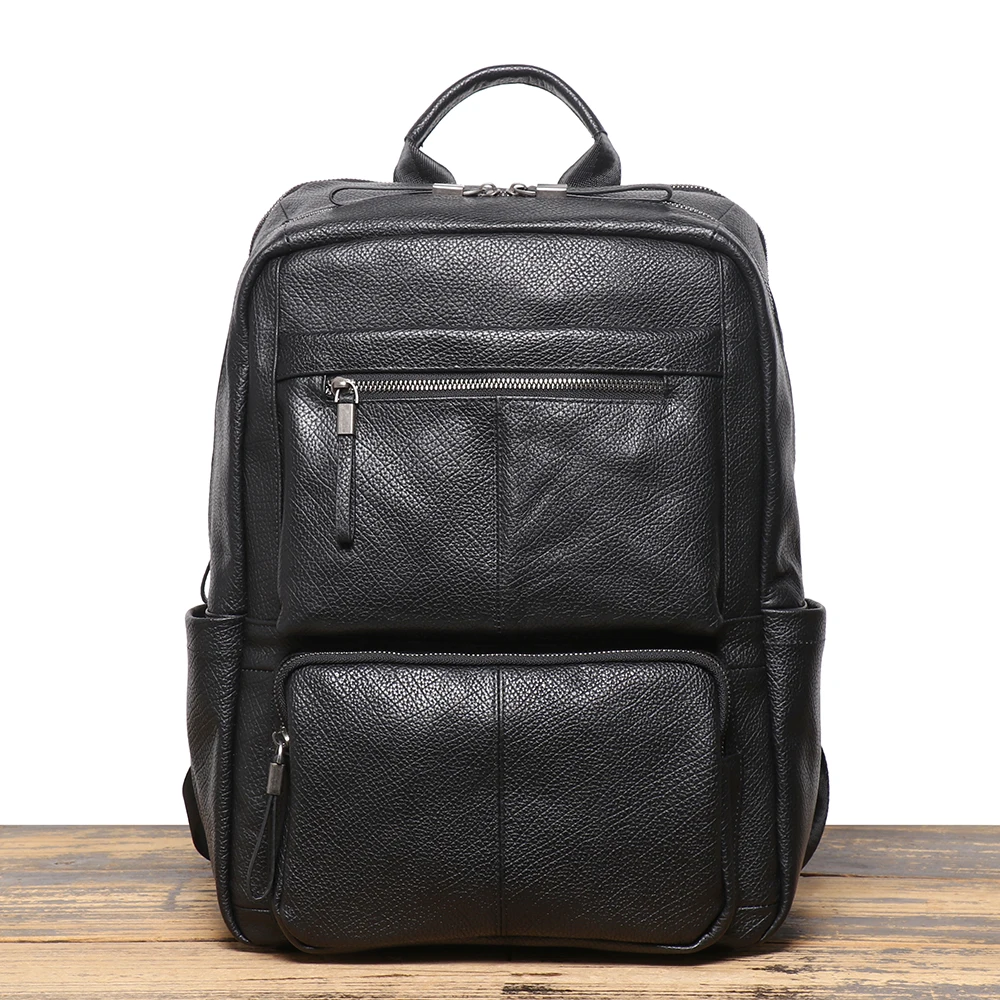
Proper Drying Techniques to Prevent Damage
After cleaning your leather backpack, proper drying is crucial to prevent warping, cracking, or mold growth.
Do’s:
* Air dry naturally at room temperature
* Place the backpack in a well-ventilated area
* Stuff the backpack with clean paper (not newspaper) to maintain its shape
* Keep the backpack away from direct light while drying
* Leave zippers and pockets open for better air circulation
Don’ts:
* Never use a hairdryer, heater, or direct heat source
* Avoid placing in direct sunlight
* Don’t use a clothes dryer
* Never rush the drying process
* Don’t apply conditioner until completely dry
The ideal drying environment is room temperature (65-75°F) with moderate humidity. Complete drying typically takes 24-48 hours depending on how damp the leather became during cleaning. Making sure leather dries properly before conditioning is essential for maintaining its quality and appearance.
Conditioning: Restoring Moisture and Suppleness
Conditioning is an essential step after cleaning that replenishes oils and maintains the leather’s suppleness:
Ensure complete drying: Your backpack must be 100% dry before applying conditioner.
Choose the right conditioner: Select a product appropriate for your leather type—cream-based for most smooth leathers, specialized products for suede or patent leather.
Test first: Apply a small amount to an inconspicuous area and check for color changes after it dries.
Apply properly: Using a soft cloth, apply a small amount of conditioner in thin, even layers using gentle circular motions.
Focus on dry areas: Pay extra attention to areas that bend frequently or appear dry.
Allow absorption time: Let the conditioner penetrate for the time recommended on the product (typically 15-30 minutes).
Buff gently: Using a clean cloth, buff the surface to remove excess conditioner and enhance shine.
Conditioning frequency depends on usage and environment—typically every 3-6 months for regularly used backpacks, more often in dry climates. High-quality luxury leather backpacks benefit tremendously from regular conditioning, which maintains their premium appearance and feel.
Advanced Stain Removal Techniques
For stubborn stains that resist regular cleaning, these specialized techniques can help:
Water Stains and Rings:
1. Dampen a clean cloth uniformly.
2. Gently wipe the entire panel containing the water stain to create even moisture.
3. Allow to dry naturally, then condition.
Grease and Oil Stains:
1. Blot excess oil without rubbing.
2. Apply cornstarch or baking powder to absorb the oil.
3. Let sit for several hours or overnight.
4. Brush away powder and clean normally.
Ink Stains:
1. For fresh ink, blot immediately without rubbing.
2. Apply a small amount of alcohol-based leather cleaner using a cotton swab.
3. Work from outside of the stain inward.
4. Clean and condition the area after treatment.
Scuffs and Abrasions:
1. For minor scuffs, gently rub with a clean finger to warm the leather.
2. For deeper scuffs, apply a tiny amount of matching leather cream.
3. Buff gently with a soft cloth.
Mold and Mildew:
1. Take the backpack outside to avoid spreading spores.
2. Wipe with a cloth dampened with a solution of equal parts water and rubbing alcohol.
3. Dry thoroughly and condition.
Food and Beverage Spills:
1. Blot immediately with an absorbent cloth.
2. For dried stains, gently clean with appropriate leather cleaner.
3. For protein stains (like milk), avoid hot water which can set the stain.
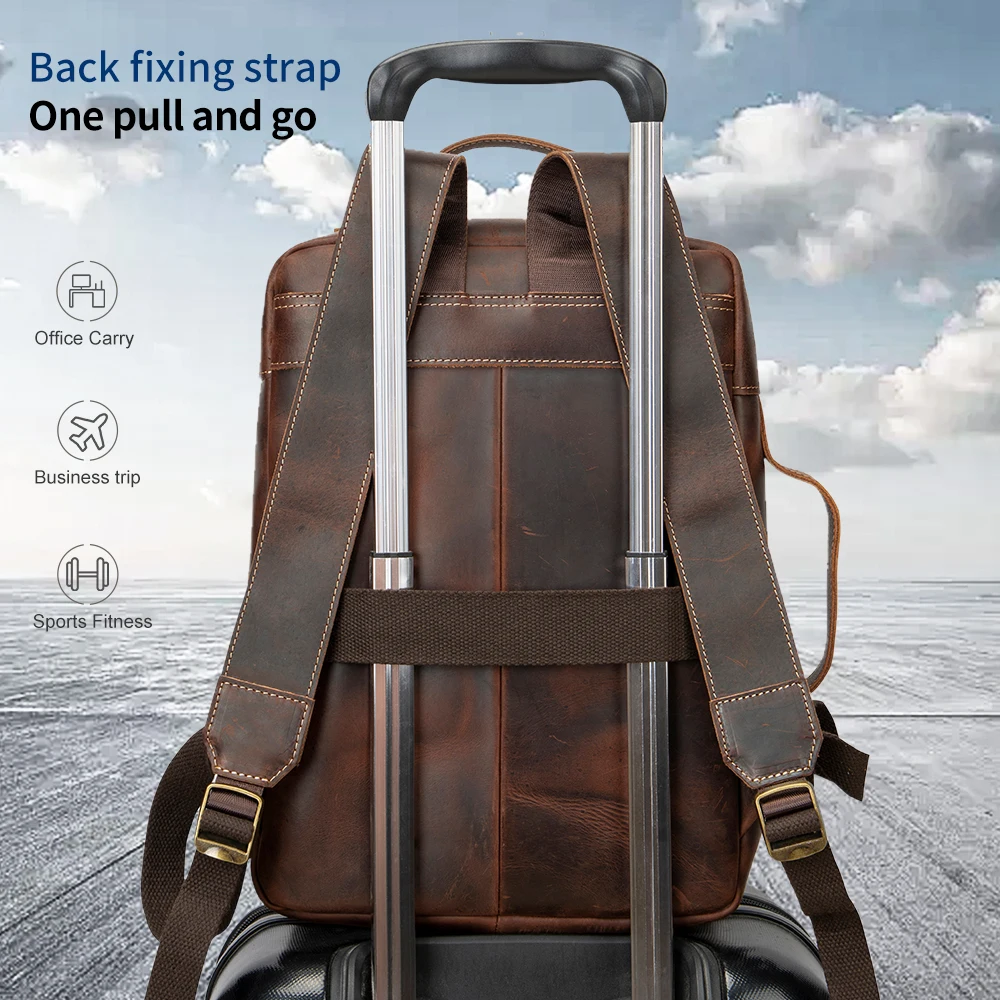
Special Care Instructions for Delicate Leather Types
Some leather types require unique approaches to cleaning and maintenance:
Suede and Nubuck Care:
* Use only brushes specifically designed for suede.
* Brush in one direction to restore nap.
* Use specialized suede erasers for small stains.
* Apply suede protector spray after cleaning.
* Never use water-based cleaners or conditioners on suede.
Patent Leather Maintenance:
* Clean with a cloth dampened with mild soapy water.
* Dry immediately with a soft cloth.
* Use specialized patent leather polish to restore shine.
* Remove scuffs with a small amount of petroleum jelly.
* Avoid alcohol-based products which can strip the finish.
Exotic Leather Considerations:
* Often requires professional cleaning.
* Use only products specifically formulated for exotic leathers.
* Test any product on an inconspicuous area first.
* Apply conditioner more frequently as exotic leathers can dry out faster.
Vintage Leather Care:
* Clean more gently than new leather.
* Use minimal moisture.
* Apply conditioner more frequently to prevent cracking.
* Accept that some patina and marks are part of the character.
Vintage leather backpacks require especially careful handling, as their aged leather may have different porosity and fragility compared to newer materials.
Essential Do’s and Don’ts for Leather Backpack Care
| Do’s | Don’ts |
|---|---|
| Clean spills immediately | Use harsh chemicals or alcohol-based products |
| Test all products on inconspicuous areas first | Soak or saturate leather with water |
| Use leather-specific products | Expose to direct sunlight or heat sources |
| Store properly with stuffing to maintain shape | Use household cleaners (Windex, bleach, etc.) |
| Apply conditioner regularly | Machine wash or tumble dry |
| Keep away from extreme temperatures | Use colored cloths that might transfer dye |
| Handle with clean hands | Apply oils not designed for leather (olive oil, etc.) |
| Use a rain cover in heavy precipitation | Ignore small issues until they become big problems |
In emergencies, blot spills immediately without rubbing, and if serious damage occurs (like large ink stains or mold), consult a professional leather cleaner. Understanding whether oiling leather provides waterproofing can help you make better decisions about protecting your backpack.
Preventative Maintenance Schedule
Regular maintenance prevents major cleaning challenges and extends your backpack’s life:
Daily Care:
* Wipe down with a dry cloth after use
* Empty contents when not in use
* Store properly, hung up or stuffed to maintain shape
* Keep away from direct sunlight and heat sources
Weekly Maintenance:
* Thorough dusting with appropriate brush
* Check for new stains or damage
* Spot clean as needed
* Inspect hardware and zippers
Monthly Care:
* Assess need for conditioning
* Check for wear on stress points
* Clean interior with a vacuum attachment
* Apply leather protection products as needed
Seasonal Protection:
* Apply waterproofing before rainy seasons
* Use UV protection products before summer
* Deeper conditioning before winter
* Consider professional cleaning annually
Long-term Storage:
* Clean thoroughly before storing
* Condition well
* Stuff with acid-free paper to maintain shape
* Cover with breathable cloth (never plastic)
* Store in cool, dry place away from sunlight
For frequently used backpacks, like those carried daily by commuters, more frequent care may be necessary to combat the effects of regular handling and exposure.
14 Inch Leather Laptop Backpack, Brown Leather Backpack, Men's Leather Backpack, Vintage Leather Backpack
Price range: $177.28 through $199.12 Select options This product has multiple variants. The options may be chosen on the product pageCarry On Leather Backpack, Roll Top Leather Backpack
Price range: $77.76 through $96.48 Select options This product has multiple variants. The options may be chosen on the product pageDesigner Mini Backpack, Mini Leather Backpack, Small Leather Sling Backpack, Women's Leather Backpack
Price range: $95.76 through $98.80 Select options This product has multiple variants. The options may be chosen on the product pageDesigner Mini Backpack, Designer Women's Backpack, Mini Leather Backpack, Women's Leather Backpack
Price range: $135.92 through $137.64 Select options This product has multiple variants. The options may be chosen on the product pageBlack Leather Backpack, Small Leather Backpack, Women's Leather Backpack
Price range: $112.96 through $116.12 Select options This product has multiple variants. The options may be chosen on the product page- Price range: $80.72 through $108.04 Select options This product has multiple variants. The options may be chosen on the product page
When to Seek Professional Leather Cleaning
While DIY cleaning works for routine maintenance, certain situations call for professional help:
Signs you need professional cleaning:
* Deep, set-in stains that resist home treatments
* Mold or mildew that has penetrated the leather
* Significant color loss or fading
* Stiffening or cracking leather
* Water damage that has left the leather warped
* Odors that persist after cleaning
Finding a qualified leather specialist:
* Look for specialists who work specifically with leather goods
* Check reviews and ask to see examples of previous work
* Inquire about their cleaning process and products
* Ask if they have experience with your specific leather type
Questions to ask before service:
* What cleaning methods will be used?
* Will the cleaning affect the color or finish?
* How long will the process take?
* What conditioning will be done after cleaning?
Professional cleaning typically costs between $50-150 for a backpack, depending on size, condition, and leather type. Consider the value of your backpack—high-end pieces often justify professional maintenance.
How to Revive a Severely Neglected Leather Backpack
Even a backpack that’s been neglected for years can often be restored with patience and proper techniques:
Assess the damage: Identify issues like cracking, stiffness, discoloration, or mold.
Initial cleaning: Remove surface dirt with a soft brush, then proceed with gentle cleaning using appropriate leather cleaner.
Multiple conditioning sessions: Apply thin layers of conditioner, allowing each to absorb fully before applying the next. Severely dried leather may need 3-4 applications over several days.
Restoration of flexibility: Gently flex the leather while it’s slightly damp from conditioner to help restore pliability.
Color restoration: For faded areas, consider a matching leather dye or color restorer after conditioning is complete.
Be realistic about what can be fixed—some damage may be permanent, but most backpacks can be significantly improved. If the backpack is beyond repair, it might be time to explore new leather backpack options.
Tips for Traveling with Your Leather Backpack
Pre-trip preparation: Apply leather protector at least 24 hours before traveling to create a barrier against moisture and stains.
Environmental considerations: Pack a rain cover for unexpected weather and avoid placing your backpack on rough or dirty surfaces.
Shape maintenance: When packing, distribute weight evenly and use proper packing techniques to maintain your backpack’s shape during transit.
On-the-go cleaning kit: Carry travel-sized essentials—microfiber cloth, small leather wipes, and a stain removal pen designed for leather.
Quick fixes: Address spills immediately by blotting (never rubbing) with a clean napkin or cloth.
Post-trip care: After returning home, empty and inspect your backpack, clean any new marks, and allow it to rest and recover its shape.
Climate adjustments: In humid environments, ensure good airflow around your backpack; in dry climates, condition more frequently.
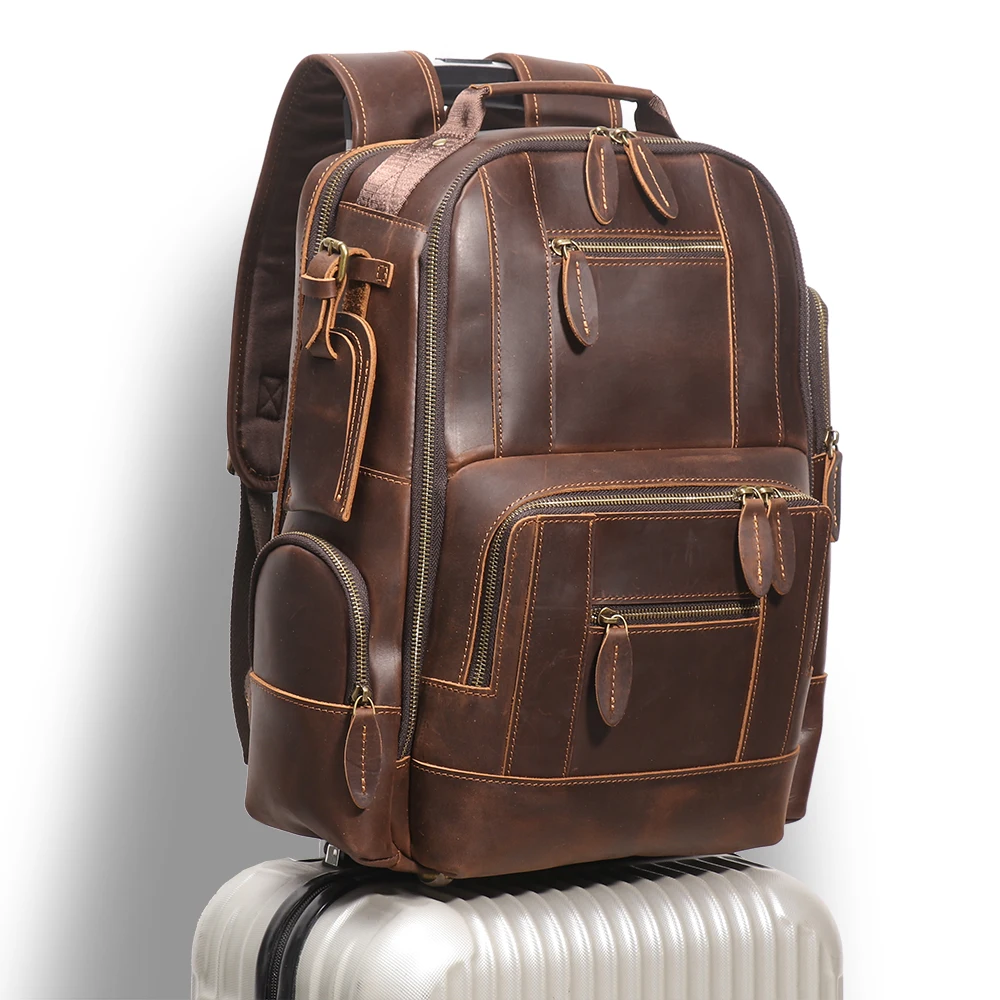
Expert Answers to Common Leather Care Questions
Q: How often should I clean my leather backpack?
A: For regular use, dust daily and clean thoroughly every 1-3 months. Clean immediately after exposure to dirt, rain, or spills.
Q: Can I restore the color of faded leather?
A: Yes, using leather color restorers or dyes designed for your specific leather type and color. Always test on a hidden area first.
Q: How do I remove scratches from my leather backpack?
A: Minor scratches often respond to gentle finger rubbing, which warms the leather and helps redistribute oils. Deeper scratches may require leather conditioner or color-matched polish.
Q: Can leather backpacks be made completely waterproof?
A: Leather is naturally water-resistant but never fully waterproof. Quality waterproofing treatments can significantly improve resistance, but in heavy rain, use a rain cover for complete protection.
Q: How do I clean tarnished hardware without damaging the leather?
A: Apply metal polish to a cotton swab and carefully treat just the metal parts. Protect surrounding leather with tape or paper if necessary.
Sustainable Leather Care: Environmentally Friendly Options
Eco-conscious leather care is increasingly important for environmentally aware consumers:
Natural cleaning alternatives:
* White vinegar diluted with water (1:1) works well for light cleaning
* Olive oil soap (castile soap) makes an excellent gentle cleanser
* Lemon juice mixed with cream of tartar can help with light stains
Eco-friendly conditioners:
* Beeswax-based conditioners provide protection without petroleum derivatives
* Plant-based waxes and oils like carnauba or jojoba oil offer sustainable alternatives
* Look for products in minimal, recyclable packaging
Sustainable practices:
* Invest in quality products that require replacement less often
* Choose concentrated products to reduce packaging waste
* Opt for reusable application cloths rather than disposable wipes
While natural products can be effective, they should still be tested in an inconspicuous area first. The goal is to balance effective leather care with environmental responsibility—a principle that Summit Carry embraces in its product design and recommended care practices.
